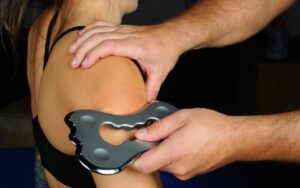by Mitch Hauschildt, MA, ATC, CSCS
As you know, I teach a number of courses to clinicians around the country, covering a variety of topics. One of my favorite courses to teach is the Rocktape FMT Blades course. FMT Blades provides evidence informed guidance with regards to how to properly perform instrument assisted soft tissue manipulation (IASTM). The techniques that we teach in this course help us to understand how the various parameters of rate, direction, depth, emollient, etc. play an important role in manipulating tissue and the nervous system to the get the outcomes that we are looking for.
Despite the information that we have at our finger tips, I continue to see many clinicians scraping just to scrape, without any real understanding as to what their goals are and what they should be doing to reach those goals. And while I believe that the Rocktape education model is the best model on the market, many other companies that are teaching IASTM techniques are also moving in the same direction, so I have hopes that as a profession, we will move in the right direction quickly with our approach.
So, I thought it would be good to review some basics on what we should be doing with our tooling over the skin.
- We should NOT be causing pain with our tools. If we are causing pain, we are driving an inflammatory process that is counterproductive to what we are trying to achieve. Tooling should be comfortable for the patient, regardless of our goals.
- We should NOT be causing soreness after the treatment is completed. If we want to cause soreness for several days with our tools, we can do that, but it is neither necessary or smart. We are trying to move forward and accelerate the inflammatory and healing process, not create more inflammation because we are beating up tissue.
- Reduce Pain: Very light touch and moderate rate is best. This approach will stimulate the free nerve endings and the Insula (happy center of the brain) to decrease pain and instill a sense of safety and control in the mind’s eye.
- Reduce Tone: Deep and slow will reduce tone in hypertonic structures. By taking a slow and steady stroke that is deep, but not painful, you will stimulate the Ruffini endings that are responsible for reducing overall tone and relaxing tissue.
- Increase Tone: Moderate depth and a fast rate work well to increase tone and change nervous system activity. If you are looking to increase tone in hypotonic tissue, accelerate motor learning, or stimulate the nervous system overall, you want to use a fast stroke to turn on the Pacinian Corpuscles and enhance nervous system activity.
- Move Fluid: Moderate, pain free, long strokes towards the heart. When you want to move fluid (swelling, edema, exercise by-products) out of local tissue, you want to use a stroke that involves enough pressure to move the fluid, but not so much that it causes pain. Use long strokes that move from distal to proximal to flush local tissue and return fluid to the main bloodstream. This can be highly effective for enhancing recovery if we desire.
- Emollient: It is completely optional. You can perform these techniques wet or dry. It’s your choice. There is evidence to support that by stimulating hair follicles, we get a better pain relieving effect because hair follicles have low threshold receptors at their best that stimulate parts of the brain associated with pain relief. There is also evidence that skin sheer may improve the stimulation of the Ruffini endings to enhance the down regulation effect of the slow, deep stroke, so it might be best to perform that stroke dry (without an emollient). Practically speaking, performing an upregulation stroke doesn’t work very well without an emollient, so if you are looking to improve tone, you likely want to use an emollient. Finally, things like clothes and tape can act as an emollient. So, if your patient has snug clothes or kinesiology tape on, then you likely don’t need an emollient to perform any of the strokes.
- Duration: Less is more. There isn’t a ton of research specifically on IASTM, but if you extrapolate the current research out there on manual therapy and apply it to IASTM, it makes sense to scrape for 90 seconds – 2 minutes and no more than 5 minutes (likely causing an acute inflammatory effect that is counterproductive). Get in, get your work done, and move on.
Don’t be afraid to mix and match these strokes. For example, if an area is spasmed and tight, it makes sense to use a light, feathering stoke for a few minutes to reduce pain and then follow it with a deep, slow stroke to reduce tone. This is where the art mixes with the science.
I hope this helps clear up some confusion regarding the variables surrounding IASTM. If you are looking to dive deeper into any of these items, I encourage you to take a FMT Blades course from Rocktape (rocktape.com). I hope to see you there!


Leave a Reply